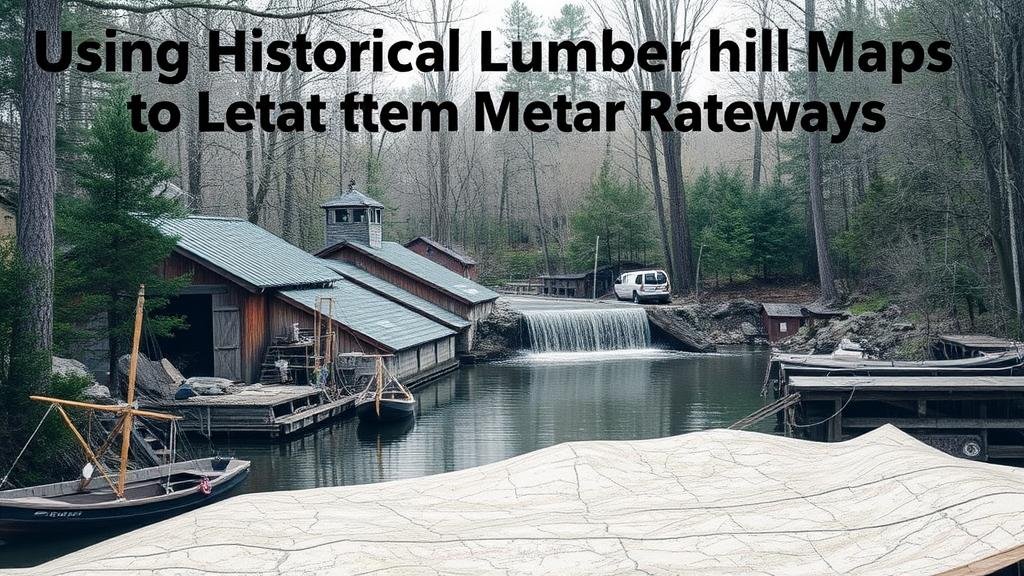Using Historical Lumber Mill Maps to Locate Metal Relics Near Waterways
Using Historical Lumber Mill Maps to Locate Metal Relics Near Waterways
The integration of historical lumber mill maps into the field of archaeology and metal detecting has revealed a rich and largely uncharted territory for enthusiasts and researchers alike. These maps serve as critical historical documents that illuminate where lumber mills operated, which often correlates with significant waterways. This article delves into the methodologies and practices of utilizing these maps to uncover valuable metal relics that reflect the industrial history of an area.
The Significance of Lumber Mills
Lumber mills have played a crucial role in the economic and industrial landscape of many regions, particularly in the United States during the 19th and early 20th centuries. establishment of mills was often strategically placed near waterways, which were essential for transporting logs and processed timber. With the decline of wooden structures and changes in industry, many of these sites have been forgotten, making them prime locations for historical exploration.
Understanding Historical Lumber Mill Maps
Historical lumber mill maps are invaluable resources that provide insights into past operational sites, transportation methods, and regional economic practices. These maps may indicate:
- The location of mills and associated facilities
- Surrounding waterways and their significance
- Access routes and infrastructure used for log transport
Different types of maps, including topographic, hydrographic, and land-use maps, can be utilized. For example, a topographic map from the late 1800s can reveal the contour of the land, helping locate abandoned mill sites based on elevation changes and proximity to rivers.
Finding the Sites of Interest
To locate metal relics effectively, one must first identify historical lumber mill locations using the following steps:
- Research and obtain historical maps from local archives, libraries, or online databases like the Library of Congress.
- Analyze the maps to determine where the mills were located in relation to major waterways.
- Cross-reference the identified locations with current geographical data to pinpoint exact locations.
This thorough background research provides a foundation for fieldwork, where metal detecting can be systematically applied.
The Role of Metal Detecting Tools
Once potential sites are identified, metal detecting becomes a crucial method in locating relics. Modern metal detectors use various frequencies and technology to differentiate between various types of metals. Key considerations for metal detecting near historical lumber mills include:
- Utilizing low frequency settings for deep targets, as remnants of machinery or tools may be buried.
- Employing discrimination settings to filter out common modern debris.
For example, a study conducted by the Society for Historical Archaeology found that detecting around the remnants of defunct mills unearthed numerous artifacts, including old tools, machinery parts, and even personal belongings that paint a picture of life during the mills operation.
Case Study: The Discovery of a 19th-Century Saw Mill
In 2021, archaeologists and metal detectorists collaborated on a project near a historical site in Oregon, where a sawmill operated from the mid-1800s to the early 1900s. By consulting historical lumber mill maps, they pinpointed the exact location where logs were turned into lumber. The fieldwork led to the discovery of:
- Iron blades and fittings, which belonged to the sawmill machinery.
- Brass nails and remnants of wood products that indicated production.â€
This successful case highlights the immense potential of combining historical maps with modern detection technology to discover lost histories.
Challenges and Considerations
While the pursuit of metal relics near historical lumber mills is promising, several challenges should be acknowledged:
- Environmental changes may obscure sites, making locations harder to identify.
- Legal regulations regarding metal detecting and artifact collection differ by state and locality.
To navigate these challenges, users must remain informed about local laws and respect private property rights, ensuring that endeavors are ethical and legally compliant.
Actionable Takeaways
Engaging with historical lumber mill maps to locate metal relics near waterways can greatly enrich the understanding of regional history. Here are some actionable takeaways for enthusiasts and researchers alike:
- Begin your search by acquiring historical maps through credible sources.
- Investigate potential sites using efficient metal detecting techniques, ensuring compliance with local regulations.
- Collaborate with local historians or archaeological groups to enhance your findings and contribute to broader historical narratives.
These practices not only support individual exploration but also contribute to the preservation and understanding of historical contexts related to lumber milling and its surrounding environments.



